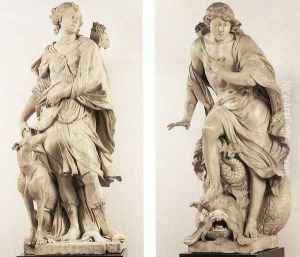Gabriel Grupello Paintings
Gabriel Grupello, born in Geraardsbergen, present-day Belgium, in 1644, was a distinguished Baroque sculptor whose work gained considerable acclaim in the late 17th and early 18th centuries. His artistic journey began under the tutelage of Artus Quellinus the Elder in Antwerp, a city renowned for its vibrant artistic community and as a center of the Baroque movement in the Southern Netherlands. Grupello's early exposure to the bustling artistic environment of Antwerp and the guidance he received from Quellinus played a crucial role in shaping his artistic sensibilities and mastery over sculptural forms.
Grupello's talent and skill soon earned him recognition beyond the borders of his homeland. His career took a significant turn when he was invited to the court of Elector Johann Wilhelm in Düsseldorf, Germany. This opportunity marked a pivotal moment in Grupello's life, bringing him into the orbit of European aristocracy and enabling him to contribute to the burgeoning Baroque landscape outside the Netherlands. At the Düsseldorf court, Grupello's work flourished, and he became known for his dynamic sculptures that embodied the Baroque spirit of movement, emotion, and theatricality. Among his notable works is the equestrian statue of Elector Johann Wilhelm, which showcases Grupello's adeptness at capturing the grandeur and power typical of Baroque portraiture.
Throughout his career, Grupello navigated the complexities of the European art world with a keen sense of ambition and a dedication to his craft. His sculptures, characterized by elaborate detail, dynamic compositions, and an expressive use of marble and bronze, earned him a place among the most esteemed sculptors of his time. Despite the challenges of working across different cultural contexts, Grupello managed to leave a lasting impact on the Baroque art scene, particularly in the territories that now encompass Belgium and Germany.
Gabriel Grupello's legacy extends beyond his death in 1730. His works continue to be studied and admired for their contribution to the development of Baroque sculpture. Grupello not only reflected the artistic trends of his time but also infused his works with a personal touch that resonates with the emotional and stylistic complexities of the Baroque era. His sculptures stand as a testament to the vibrant artistic culture of the 17th and early 18th centuries, embodying the spirit of an age that celebrated the dramatic, the emotional, and the sublime.
